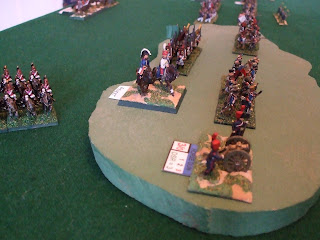When the two armies deployed, the Spanish (actually Russians as I do not have any Spanish troops) overlapped the French line due to their infantry being deployed in two long, mutually supporting lines. The cavalry were held in reserve; they like half of the infantry were second rate formations, which, if 'staggered' would be difficult to rally. A roll of the dice allocated command of the Spanish (Russians) to Steve, whilst I commanded the French. Overall the Spanish (Russians) had 26 battalions, 3 units of cavalry and 3 guns, organised into 5 divisions. The French had 20 battalions
(only 14 on the table at the beginning), 4 units of cavalry and 4 guns (one of which was with Ruffin) in 4 divisions
My plan, such as it was, was to 'soften up' the Spanish line with my artillery, then breakthrough with the cavalry and follow up with an infantry advance. Steve opted, as had Cuesta, for a steady advance, maintaining the line of infantry. He intended when in range to overwhelm the French line with musketry. The old adage "no plan survives first contact with the enemy" held true yet again. With their first shots the Russian artillery found the range, inflicting kills and 'staggers' on three of my infantry units. In reply the French artillery achieved nothing!
 |
| The Russian line stretching away into the distance |
 |
| Revest's Division |
On the opposite flank Mouton's division was faced by Gladkov's division. Mouton had two units of light cavalry and anticipated that he could drive off the Mounted Eger supporting Gladkov. However, the Russian cavalry, although 'second rate' totally destroyed the 4th Chasseurs and Mouton had to commit the 2nd Hussars to push back the Russian cavalry.
 |
| The 16th Dragoons are driven off |
In the centre, Dupas' division was taking on the divisions of Ulanius and Neverovsky. The front lines exchanged volleys, with the advantage going to the Russians. Slowly they began to gain the upper hand and then their artillery, which had moved forward joined in. Great holes were torn in the ranks of the front line and the divisional morale began to waver. By now, both Revest and Moutin were in serious trouble. Their losses were approaching 50% and disaster beckoned.
 |
| Dupas comes under increasing pressure |
The scenario notes stated that this was a hard scenario for the Spanish to win. Our battle seemed to contradict this. One major French difficulty concerned the initiative. The rules give the initiative to the army with the highest proportion of divisions on attack orders. This meant that the 5 Spanish divisions could be the first to move and the last to move; allowing them to respond to any French attacks. Our local rule has a die roll to determine the initiative, but even so the Russians could always react to any French attacks. A solution may be to adopt the Konig Krieg method of dicing for initiative after each division moves. That being said I was not helped by my delay in calling on the reserves, nor failing each divisional morale test I took.
To close I must thank those who have taken the time to post the generous comments on my last two reports, they are most appreciated by myself and Steve.

Enjoyed thanks - the rules seem to produce a very believable account.
ReplyDelete